Integrated Care for Asthma: Pharmacological and Non-Pharmacological
VerifiedAdded on 2023/01/24
|7
|2127
|81
Report
AI Summary
This report provides a comprehensive overview of integrated care for asthma, focusing on both pharmacological and non-pharmacological approaches to manage the disease. The pharmacological treatments discussed include ipratropium, prednisolone, salbutamol, amoxicillin, and paracetamol, detailing their mechanisms of action and appropriate administration. Non-pharmacological interventions, such as patient education, monitoring, and environmental control, are also highlighted. The report emphasizes the importance of a multidisciplinary approach, involving nurses, pharmacists, dieticians, and physical trainers, to provide holistic care. Prioritized nursing interventions, including monitoring vital signs, administering supplemental oxygen, and promoting proper breathing techniques, are outlined. The report also stresses the significance of educating patients and their families about asthma management, medication adherence, and potential side effects. Overall, the report underscores the need for targeted treatment and effective management to improve outcomes for asthma patients like Zachy, leading to better control of symptoms and improved quality of life.
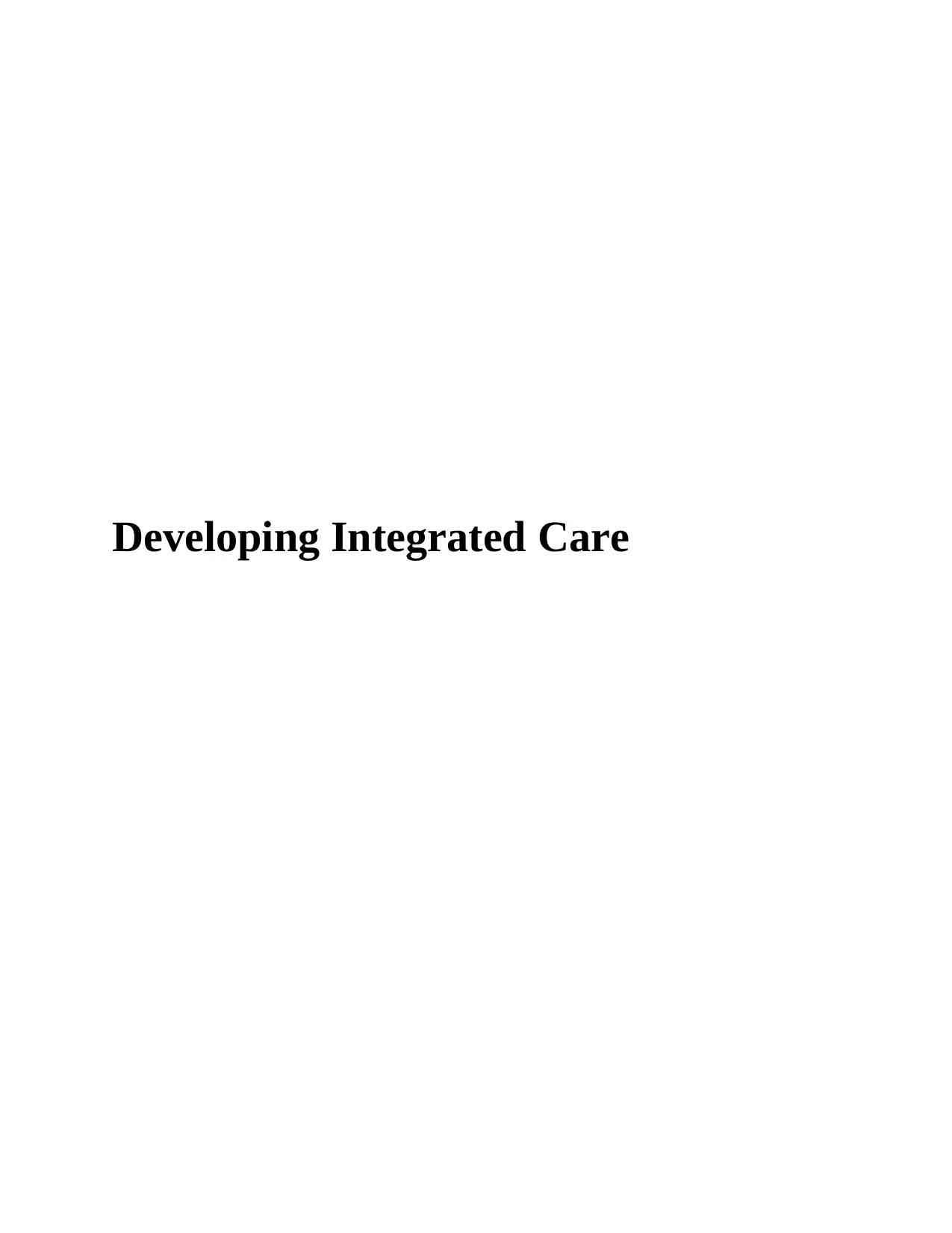
Developing Integrated Care
Paraphrase This Document
Need a fresh take? Get an instant paraphrase of this document with our AI Paraphraser
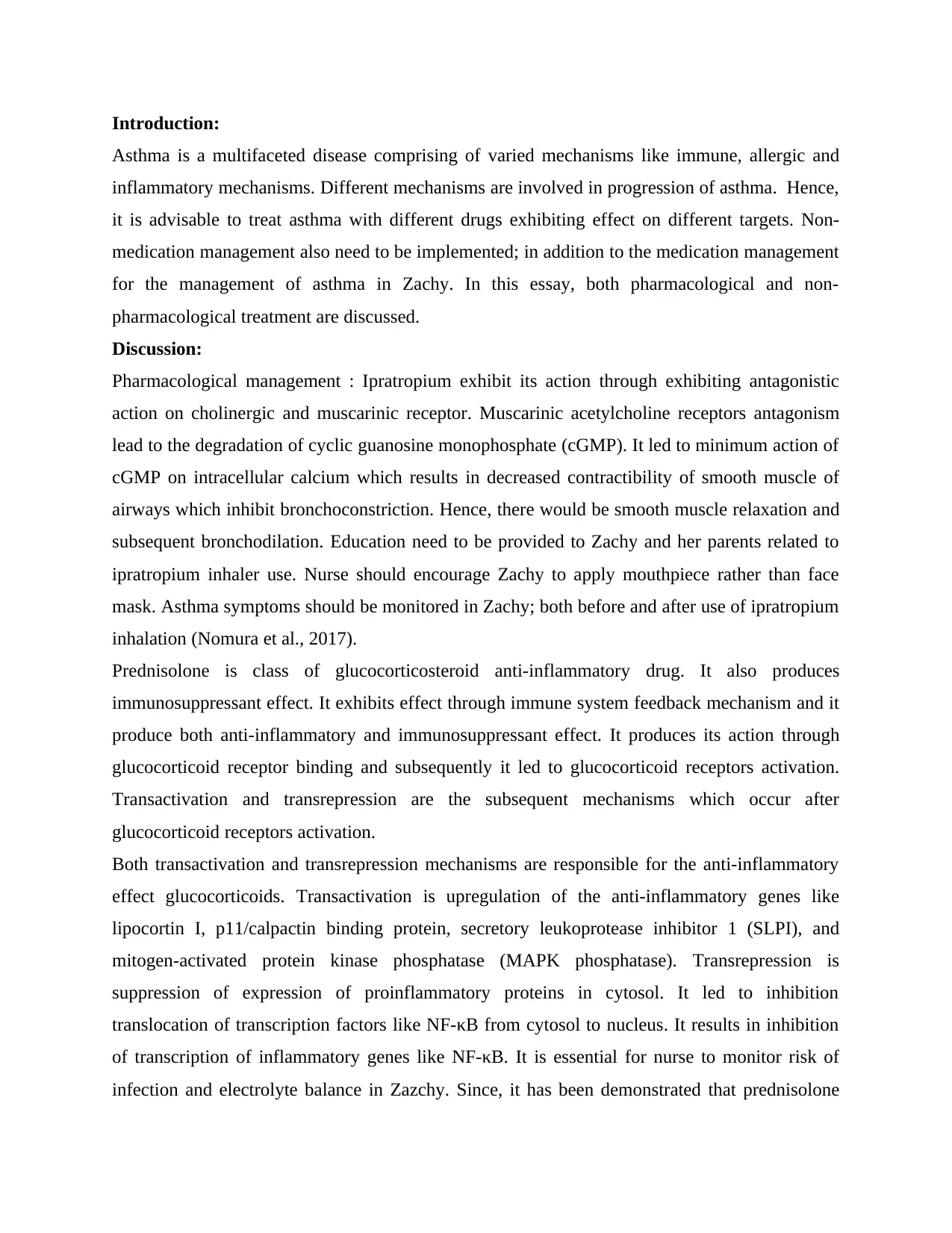
Introduction:
Asthma is a multifaceted disease comprising of varied mechanisms like immune, allergic and
inflammatory mechanisms. Different mechanisms are involved in progression of asthma. Hence,
it is advisable to treat asthma with different drugs exhibiting effect on different targets. Non-
medication management also need to be implemented; in addition to the medication management
for the management of asthma in Zachy. In this essay, both pharmacological and non-
pharmacological treatment are discussed.
Discussion:
Pharmacological management : Ipratropium exhibit its action through exhibiting antagonistic
action on cholinergic and muscarinic receptor. Muscarinic acetylcholine receptors antagonism
lead to the degradation of cyclic guanosine monophosphate (cGMP). It led to minimum action of
cGMP on intracellular calcium which results in decreased contractibility of smooth muscle of
airways which inhibit bronchoconstriction. Hence, there would be smooth muscle relaxation and
subsequent bronchodilation. Education need to be provided to Zachy and her parents related to
ipratropium inhaler use. Nurse should encourage Zachy to apply mouthpiece rather than face
mask. Asthma symptoms should be monitored in Zachy; both before and after use of ipratropium
inhalation (Nomura et al., 2017).
Prednisolone is class of glucocorticosteroid anti-inflammatory drug. It also produces
immunosuppressant effect. It exhibits effect through immune system feedback mechanism and it
produce both anti-inflammatory and immunosuppressant effect. It produces its action through
glucocorticoid receptor binding and subsequently it led to glucocorticoid receptors activation.
Transactivation and transrepression are the subsequent mechanisms which occur after
glucocorticoid receptors activation.
Both transactivation and transrepression mechanisms are responsible for the anti-inflammatory
effect glucocorticoids. Transactivation is upregulation of the anti-inflammatory genes like
lipocortin I, p11/calpactin binding protein, secretory leukoprotease inhibitor 1 (SLPI), and
mitogen-activated protein kinase phosphatase (MAPK phosphatase). Transrepression is
suppression of expression of proinflammatory proteins in cytosol. It led to inhibition
translocation of transcription factors like NF-κB from cytosol to nucleus. It results in inhibition
of transcription of inflammatory genes like NF-κB. It is essential for nurse to monitor risk of
infection and electrolyte balance in Zazchy. Since, it has been demonstrated that prednisolone
Asthma is a multifaceted disease comprising of varied mechanisms like immune, allergic and
inflammatory mechanisms. Different mechanisms are involved in progression of asthma. Hence,
it is advisable to treat asthma with different drugs exhibiting effect on different targets. Non-
medication management also need to be implemented; in addition to the medication management
for the management of asthma in Zachy. In this essay, both pharmacological and non-
pharmacological treatment are discussed.
Discussion:
Pharmacological management : Ipratropium exhibit its action through exhibiting antagonistic
action on cholinergic and muscarinic receptor. Muscarinic acetylcholine receptors antagonism
lead to the degradation of cyclic guanosine monophosphate (cGMP). It led to minimum action of
cGMP on intracellular calcium which results in decreased contractibility of smooth muscle of
airways which inhibit bronchoconstriction. Hence, there would be smooth muscle relaxation and
subsequent bronchodilation. Education need to be provided to Zachy and her parents related to
ipratropium inhaler use. Nurse should encourage Zachy to apply mouthpiece rather than face
mask. Asthma symptoms should be monitored in Zachy; both before and after use of ipratropium
inhalation (Nomura et al., 2017).
Prednisolone is class of glucocorticosteroid anti-inflammatory drug. It also produces
immunosuppressant effect. It exhibits effect through immune system feedback mechanism and it
produce both anti-inflammatory and immunosuppressant effect. It produces its action through
glucocorticoid receptor binding and subsequently it led to glucocorticoid receptors activation.
Transactivation and transrepression are the subsequent mechanisms which occur after
glucocorticoid receptors activation.
Both transactivation and transrepression mechanisms are responsible for the anti-inflammatory
effect glucocorticoids. Transactivation is upregulation of the anti-inflammatory genes like
lipocortin I, p11/calpactin binding protein, secretory leukoprotease inhibitor 1 (SLPI), and
mitogen-activated protein kinase phosphatase (MAPK phosphatase). Transrepression is
suppression of expression of proinflammatory proteins in cytosol. It led to inhibition
translocation of transcription factors like NF-κB from cytosol to nucleus. It results in inhibition
of transcription of inflammatory genes like NF-κB. It is essential for nurse to monitor risk of
infection and electrolyte balance in Zazchy. Since, it has been demonstrated that prednisolone
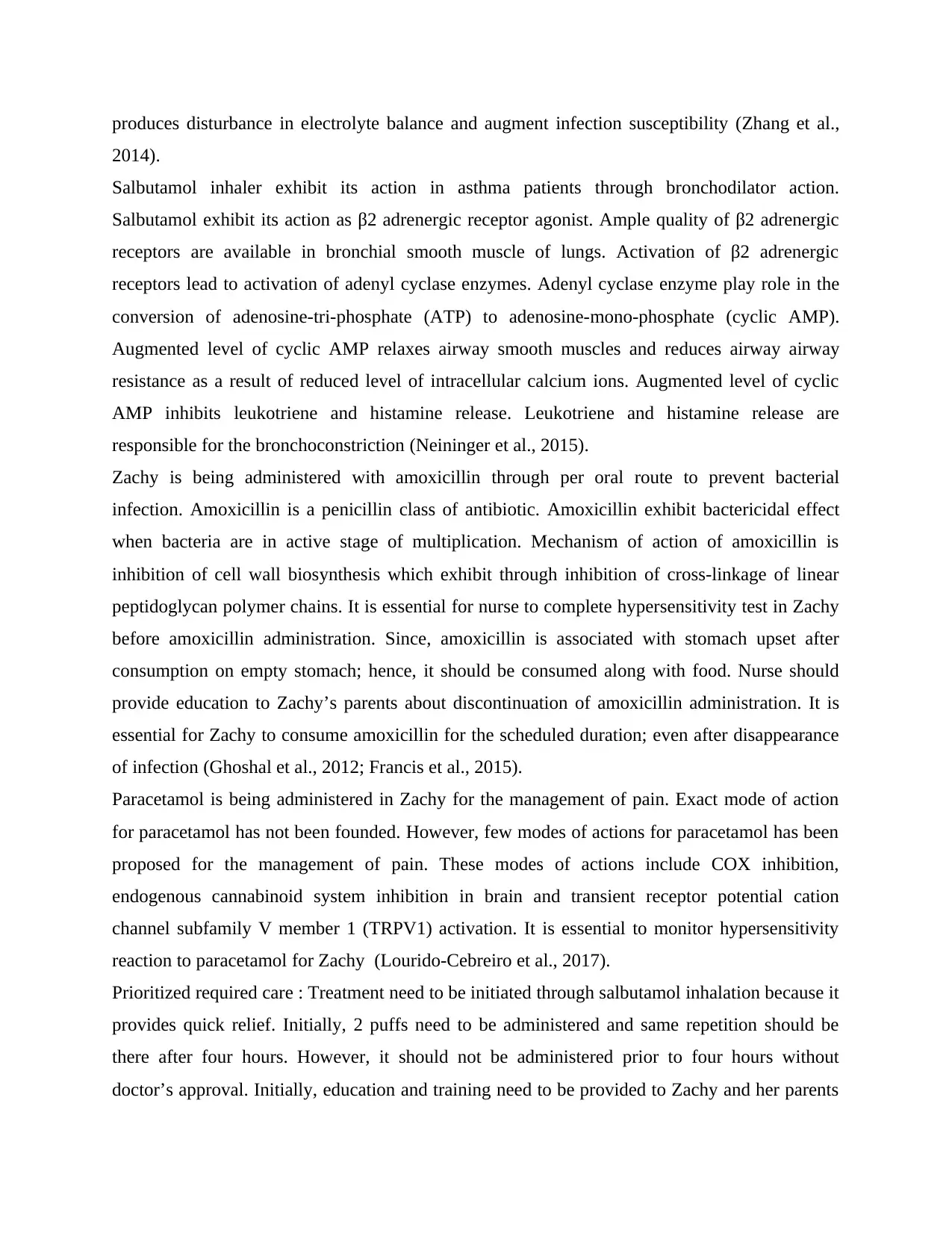
produces disturbance in electrolyte balance and augment infection susceptibility (Zhang et al.,
2014).
Salbutamol inhaler exhibit its action in asthma patients through bronchodilator action.
Salbutamol exhibit its action as β2 adrenergic receptor agonist. Ample quality of β2 adrenergic
receptors are available in bronchial smooth muscle of lungs. Activation of β2 adrenergic
receptors lead to activation of adenyl cyclase enzymes. Adenyl cyclase enzyme play role in the
conversion of adenosine-tri-phosphate (ATP) to adenosine-mono-phosphate (cyclic AMP).
Augmented level of cyclic AMP relaxes airway smooth muscles and reduces airway airway
resistance as a result of reduced level of intracellular calcium ions. Augmented level of cyclic
AMP inhibits leukotriene and histamine release. Leukotriene and histamine release are
responsible for the bronchoconstriction (Neininger et al., 2015).
Zachy is being administered with amoxicillin through per oral route to prevent bacterial
infection. Amoxicillin is a penicillin class of antibiotic. Amoxicillin exhibit bactericidal effect
when bacteria are in active stage of multiplication. Mechanism of action of amoxicillin is
inhibition of cell wall biosynthesis which exhibit through inhibition of cross-linkage of linear
peptidoglycan polymer chains. It is essential for nurse to complete hypersensitivity test in Zachy
before amoxicillin administration. Since, amoxicillin is associated with stomach upset after
consumption on empty stomach; hence, it should be consumed along with food. Nurse should
provide education to Zachy’s parents about discontinuation of amoxicillin administration. It is
essential for Zachy to consume amoxicillin for the scheduled duration; even after disappearance
of infection (Ghoshal et al., 2012; Francis et al., 2015).
Paracetamol is being administered in Zachy for the management of pain. Exact mode of action
for paracetamol has not been founded. However, few modes of actions for paracetamol has been
proposed for the management of pain. These modes of actions include COX inhibition,
endogenous cannabinoid system inhibition in brain and transient receptor potential cation
channel subfamily V member 1 (TRPV1) activation. It is essential to monitor hypersensitivity
reaction to paracetamol for Zachy (Lourido-Cebreiro et al., 2017).
Prioritized required care : Treatment need to be initiated through salbutamol inhalation because it
provides quick relief. Initially, 2 puffs need to be administered and same repetition should be
there after four hours. However, it should not be administered prior to four hours without
doctor’s approval. Initially, education and training need to be provided to Zachy and her parents
2014).
Salbutamol inhaler exhibit its action in asthma patients through bronchodilator action.
Salbutamol exhibit its action as β2 adrenergic receptor agonist. Ample quality of β2 adrenergic
receptors are available in bronchial smooth muscle of lungs. Activation of β2 adrenergic
receptors lead to activation of adenyl cyclase enzymes. Adenyl cyclase enzyme play role in the
conversion of adenosine-tri-phosphate (ATP) to adenosine-mono-phosphate (cyclic AMP).
Augmented level of cyclic AMP relaxes airway smooth muscles and reduces airway airway
resistance as a result of reduced level of intracellular calcium ions. Augmented level of cyclic
AMP inhibits leukotriene and histamine release. Leukotriene and histamine release are
responsible for the bronchoconstriction (Neininger et al., 2015).
Zachy is being administered with amoxicillin through per oral route to prevent bacterial
infection. Amoxicillin is a penicillin class of antibiotic. Amoxicillin exhibit bactericidal effect
when bacteria are in active stage of multiplication. Mechanism of action of amoxicillin is
inhibition of cell wall biosynthesis which exhibit through inhibition of cross-linkage of linear
peptidoglycan polymer chains. It is essential for nurse to complete hypersensitivity test in Zachy
before amoxicillin administration. Since, amoxicillin is associated with stomach upset after
consumption on empty stomach; hence, it should be consumed along with food. Nurse should
provide education to Zachy’s parents about discontinuation of amoxicillin administration. It is
essential for Zachy to consume amoxicillin for the scheduled duration; even after disappearance
of infection (Ghoshal et al., 2012; Francis et al., 2015).
Paracetamol is being administered in Zachy for the management of pain. Exact mode of action
for paracetamol has not been founded. However, few modes of actions for paracetamol has been
proposed for the management of pain. These modes of actions include COX inhibition,
endogenous cannabinoid system inhibition in brain and transient receptor potential cation
channel subfamily V member 1 (TRPV1) activation. It is essential to monitor hypersensitivity
reaction to paracetamol for Zachy (Lourido-Cebreiro et al., 2017).
Prioritized required care : Treatment need to be initiated through salbutamol inhalation because it
provides quick relief. Initially, 2 puffs need to be administered and same repetition should be
there after four hours. However, it should not be administered prior to four hours without
doctor’s approval. Initially, education and training need to be provided to Zachy and her parents
⊘ This is a preview!⊘
Do you want full access?
Subscribe today to unlock all pages.

Trusted by 1+ million students worldwide
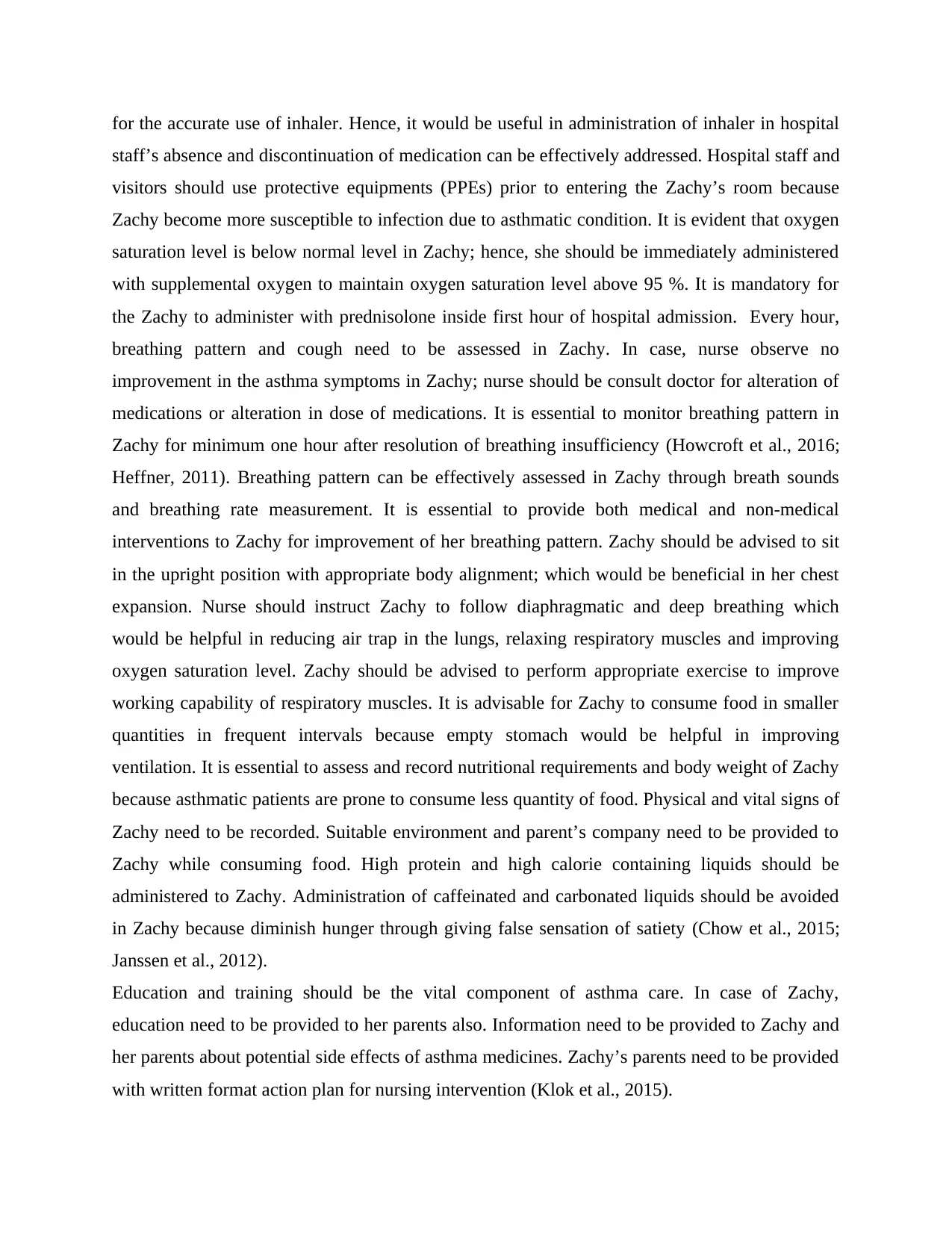
for the accurate use of inhaler. Hence, it would be useful in administration of inhaler in hospital
staff’s absence and discontinuation of medication can be effectively addressed. Hospital staff and
visitors should use protective equipments (PPEs) prior to entering the Zachy’s room because
Zachy become more susceptible to infection due to asthmatic condition. It is evident that oxygen
saturation level is below normal level in Zachy; hence, she should be immediately administered
with supplemental oxygen to maintain oxygen saturation level above 95 %. It is mandatory for
the Zachy to administer with prednisolone inside first hour of hospital admission. Every hour,
breathing pattern and cough need to be assessed in Zachy. In case, nurse observe no
improvement in the asthma symptoms in Zachy; nurse should be consult doctor for alteration of
medications or alteration in dose of medications. It is essential to monitor breathing pattern in
Zachy for minimum one hour after resolution of breathing insufficiency (Howcroft et al., 2016;
Heffner, 2011). Breathing pattern can be effectively assessed in Zachy through breath sounds
and breathing rate measurement. It is essential to provide both medical and non-medical
interventions to Zachy for improvement of her breathing pattern. Zachy should be advised to sit
in the upright position with appropriate body alignment; which would be beneficial in her chest
expansion. Nurse should instruct Zachy to follow diaphragmatic and deep breathing which
would be helpful in reducing air trap in the lungs, relaxing respiratory muscles and improving
oxygen saturation level. Zachy should be advised to perform appropriate exercise to improve
working capability of respiratory muscles. It is advisable for Zachy to consume food in smaller
quantities in frequent intervals because empty stomach would be helpful in improving
ventilation. It is essential to assess and record nutritional requirements and body weight of Zachy
because asthmatic patients are prone to consume less quantity of food. Physical and vital signs of
Zachy need to be recorded. Suitable environment and parent’s company need to be provided to
Zachy while consuming food. High protein and high calorie containing liquids should be
administered to Zachy. Administration of caffeinated and carbonated liquids should be avoided
in Zachy because diminish hunger through giving false sensation of satiety (Chow et al., 2015;
Janssen et al., 2012).
Education and training should be the vital component of asthma care. In case of Zachy,
education need to be provided to her parents also. Information need to be provided to Zachy and
her parents about potential side effects of asthma medicines. Zachy’s parents need to be provided
with written format action plan for nursing intervention (Klok et al., 2015).
staff’s absence and discontinuation of medication can be effectively addressed. Hospital staff and
visitors should use protective equipments (PPEs) prior to entering the Zachy’s room because
Zachy become more susceptible to infection due to asthmatic condition. It is evident that oxygen
saturation level is below normal level in Zachy; hence, she should be immediately administered
with supplemental oxygen to maintain oxygen saturation level above 95 %. It is mandatory for
the Zachy to administer with prednisolone inside first hour of hospital admission. Every hour,
breathing pattern and cough need to be assessed in Zachy. In case, nurse observe no
improvement in the asthma symptoms in Zachy; nurse should be consult doctor for alteration of
medications or alteration in dose of medications. It is essential to monitor breathing pattern in
Zachy for minimum one hour after resolution of breathing insufficiency (Howcroft et al., 2016;
Heffner, 2011). Breathing pattern can be effectively assessed in Zachy through breath sounds
and breathing rate measurement. It is essential to provide both medical and non-medical
interventions to Zachy for improvement of her breathing pattern. Zachy should be advised to sit
in the upright position with appropriate body alignment; which would be beneficial in her chest
expansion. Nurse should instruct Zachy to follow diaphragmatic and deep breathing which
would be helpful in reducing air trap in the lungs, relaxing respiratory muscles and improving
oxygen saturation level. Zachy should be advised to perform appropriate exercise to improve
working capability of respiratory muscles. It is advisable for Zachy to consume food in smaller
quantities in frequent intervals because empty stomach would be helpful in improving
ventilation. It is essential to assess and record nutritional requirements and body weight of Zachy
because asthmatic patients are prone to consume less quantity of food. Physical and vital signs of
Zachy need to be recorded. Suitable environment and parent’s company need to be provided to
Zachy while consuming food. High protein and high calorie containing liquids should be
administered to Zachy. Administration of caffeinated and carbonated liquids should be avoided
in Zachy because diminish hunger through giving false sensation of satiety (Chow et al., 2015;
Janssen et al., 2012).
Education and training should be the vital component of asthma care. In case of Zachy,
education need to be provided to her parents also. Information need to be provided to Zachy and
her parents about potential side effects of asthma medicines. Zachy’s parents need to be provided
with written format action plan for nursing intervention (Klok et al., 2015).
Paraphrase This Document
Need a fresh take? Get an instant paraphrase of this document with our AI Paraphraser
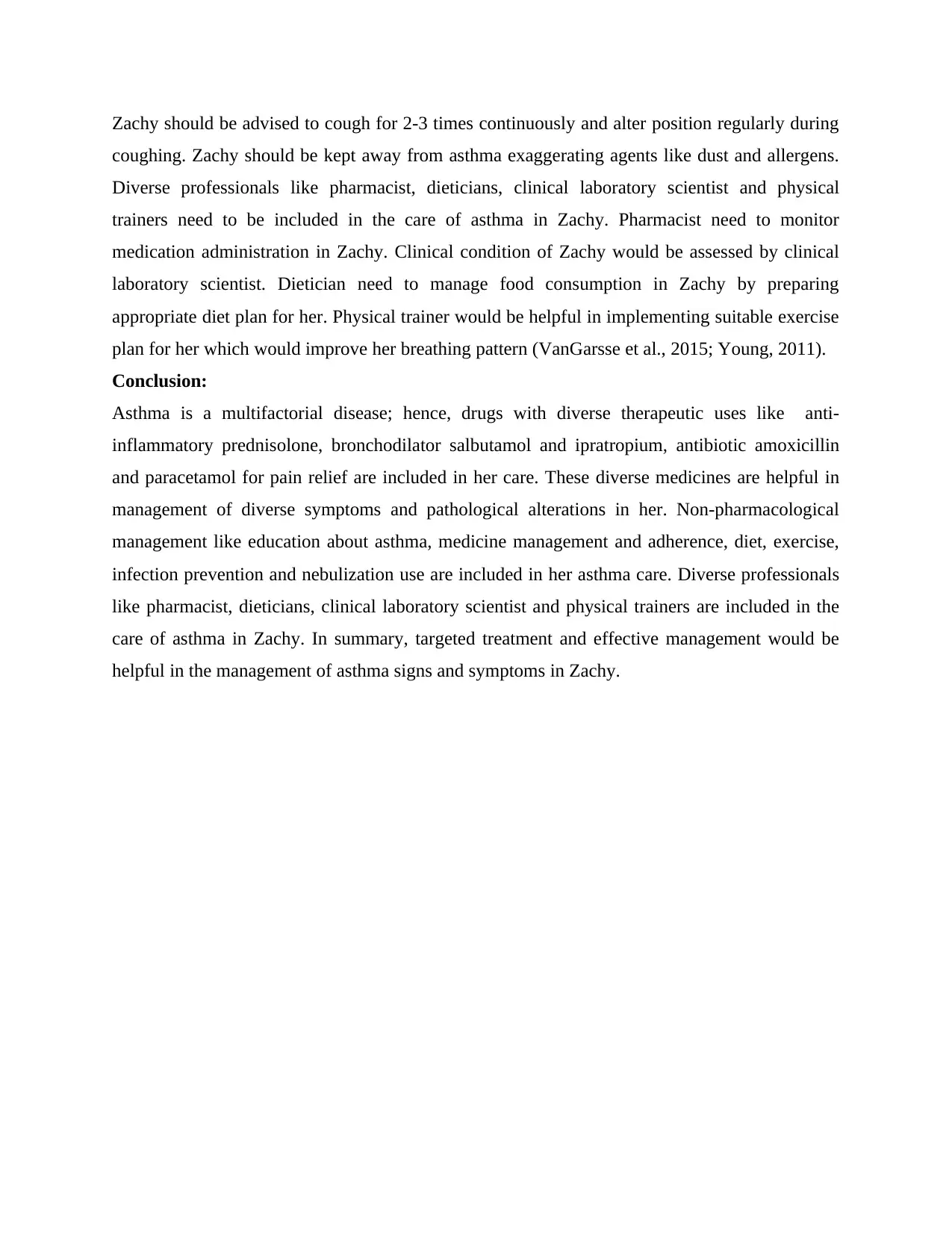
Zachy should be advised to cough for 2-3 times continuously and alter position regularly during
coughing. Zachy should be kept away from asthma exaggerating agents like dust and allergens.
Diverse professionals like pharmacist, dieticians, clinical laboratory scientist and physical
trainers need to be included in the care of asthma in Zachy. Pharmacist need to monitor
medication administration in Zachy. Clinical condition of Zachy would be assessed by clinical
laboratory scientist. Dietician need to manage food consumption in Zachy by preparing
appropriate diet plan for her. Physical trainer would be helpful in implementing suitable exercise
plan for her which would improve her breathing pattern (VanGarsse et al., 2015; Young, 2011).
Conclusion:
Asthma is a multifactorial disease; hence, drugs with diverse therapeutic uses like anti-
inflammatory prednisolone, bronchodilator salbutamol and ipratropium, antibiotic amoxicillin
and paracetamol for pain relief are included in her care. These diverse medicines are helpful in
management of diverse symptoms and pathological alterations in her. Non-pharmacological
management like education about asthma, medicine management and adherence, diet, exercise,
infection prevention and nebulization use are included in her asthma care. Diverse professionals
like pharmacist, dieticians, clinical laboratory scientist and physical trainers are included in the
care of asthma in Zachy. In summary, targeted treatment and effective management would be
helpful in the management of asthma signs and symptoms in Zachy.
coughing. Zachy should be kept away from asthma exaggerating agents like dust and allergens.
Diverse professionals like pharmacist, dieticians, clinical laboratory scientist and physical
trainers need to be included in the care of asthma in Zachy. Pharmacist need to monitor
medication administration in Zachy. Clinical condition of Zachy would be assessed by clinical
laboratory scientist. Dietician need to manage food consumption in Zachy by preparing
appropriate diet plan for her. Physical trainer would be helpful in implementing suitable exercise
plan for her which would improve her breathing pattern (VanGarsse et al., 2015; Young, 2011).
Conclusion:
Asthma is a multifactorial disease; hence, drugs with diverse therapeutic uses like anti-
inflammatory prednisolone, bronchodilator salbutamol and ipratropium, antibiotic amoxicillin
and paracetamol for pain relief are included in her care. These diverse medicines are helpful in
management of diverse symptoms and pathological alterations in her. Non-pharmacological
management like education about asthma, medicine management and adherence, diet, exercise,
infection prevention and nebulization use are included in her asthma care. Diverse professionals
like pharmacist, dieticians, clinical laboratory scientist and physical trainers are included in the
care of asthma in Zachy. In summary, targeted treatment and effective management would be
helpful in the management of asthma signs and symptoms in Zachy.
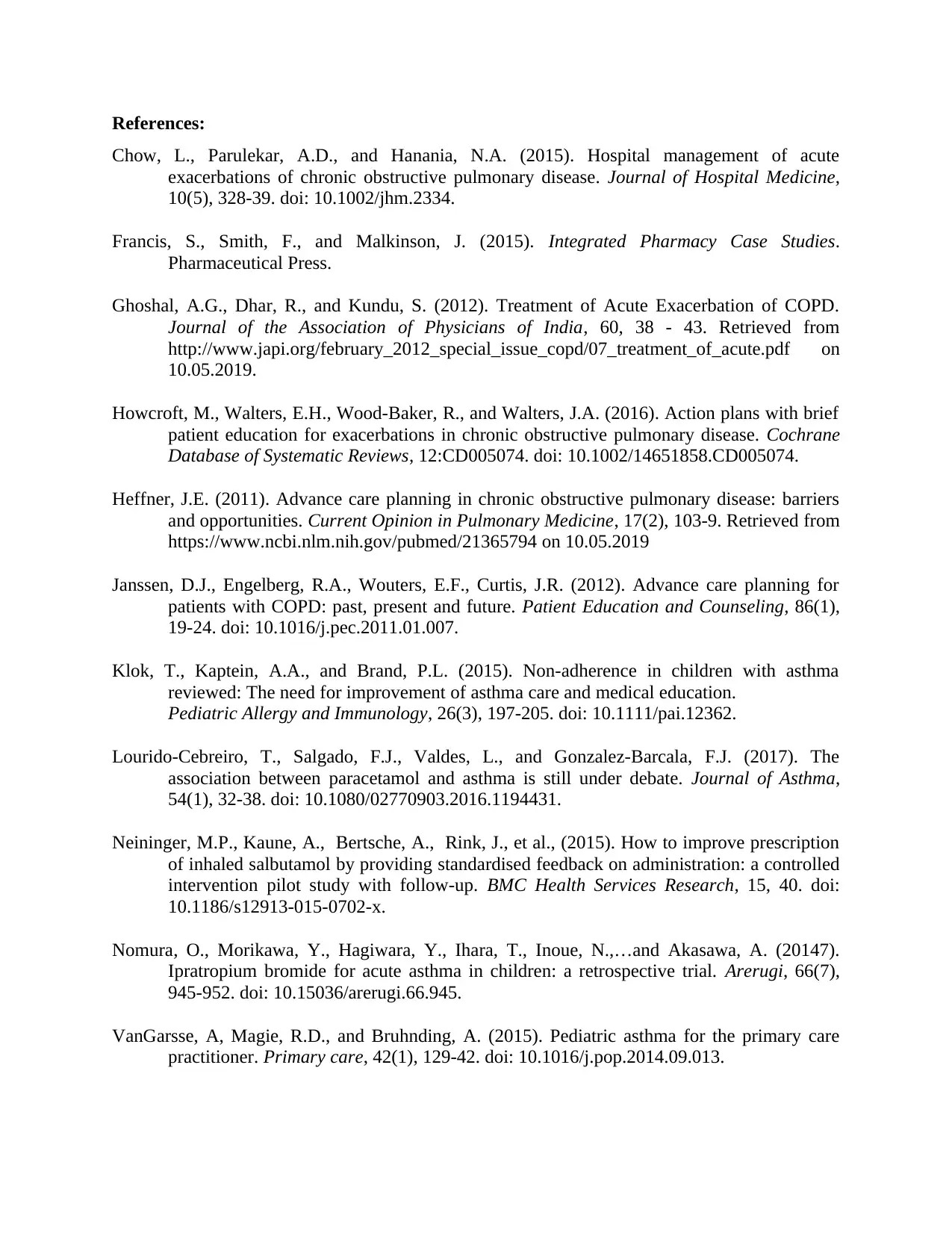
References:
Chow, L., Parulekar, A.D., and Hanania, N.A. (2015). Hospital management of acute
exacerbations of chronic obstructive pulmonary disease. Journal of Hospital Medicine,
10(5), 328-39. doi: 10.1002/jhm.2334.
Francis, S., Smith, F., and Malkinson, J. (2015). Integrated Pharmacy Case Studies.
Pharmaceutical Press.
Ghoshal, A.G., Dhar, R., and Kundu, S. (2012). Treatment of Acute Exacerbation of COPD.
Journal of the Association of Physicians of India, 60, 38 - 43. Retrieved from
http://www.japi.org/february_2012_special_issue_copd/07_treatment_of_acute.pdf on
10.05.2019.
Howcroft, M., Walters, E.H., Wood-Baker, R., and Walters, J.A. (2016). Action plans with brief
patient education for exacerbations in chronic obstructive pulmonary disease. Cochrane
Database of Systematic Reviews, 12:CD005074. doi: 10.1002/14651858.CD005074.
Heffner, J.E. (2011). Advance care planning in chronic obstructive pulmonary disease: barriers
and opportunities. Current Opinion in Pulmonary Medicine, 17(2), 103-9. Retrieved from
https://www.ncbi.nlm.nih.gov/pubmed/21365794 on 10.05.2019
Janssen, D.J., Engelberg, R.A., Wouters, E.F., Curtis, J.R. (2012). Advance care planning for
patients with COPD: past, present and future. Patient Education and Counseling, 86(1),
19-24. doi: 10.1016/j.pec.2011.01.007.
Klok, T., Kaptein, A.A., and Brand, P.L. (2015). Non-adherence in children with asthma
reviewed: The need for improvement of asthma care and medical education.
Pediatric Allergy and Immunology, 26(3), 197-205. doi: 10.1111/pai.12362.
Lourido-Cebreiro, T., Salgado, F.J., Valdes, L., and Gonzalez-Barcala, F.J. (2017). The
association between paracetamol and asthma is still under debate. Journal of Asthma,
54(1), 32-38. doi: 10.1080/02770903.2016.1194431.
Neininger, M.P., Kaune, A., Bertsche, A., Rink, J., et al., (2015). How to improve prescription
of inhaled salbutamol by providing standardised feedback on administration: a controlled
intervention pilot study with follow-up. BMC Health Services Research, 15, 40. doi:
10.1186/s12913-015-0702-x.
Nomura, O., Morikawa, Y., Hagiwara, Y., Ihara, T., Inoue, N.,…and Akasawa, A. (20147).
Ipratropium bromide for acute asthma in children: a retrospective trial. Arerugi, 66(7),
945-952. doi: 10.15036/arerugi.66.945.
VanGarsse, A, Magie, R.D., and Bruhnding, A. (2015). Pediatric asthma for the primary care
practitioner. Primary care, 42(1), 129-42. doi: 10.1016/j.pop.2014.09.013.
Chow, L., Parulekar, A.D., and Hanania, N.A. (2015). Hospital management of acute
exacerbations of chronic obstructive pulmonary disease. Journal of Hospital Medicine,
10(5), 328-39. doi: 10.1002/jhm.2334.
Francis, S., Smith, F., and Malkinson, J. (2015). Integrated Pharmacy Case Studies.
Pharmaceutical Press.
Ghoshal, A.G., Dhar, R., and Kundu, S. (2012). Treatment of Acute Exacerbation of COPD.
Journal of the Association of Physicians of India, 60, 38 - 43. Retrieved from
http://www.japi.org/february_2012_special_issue_copd/07_treatment_of_acute.pdf on
10.05.2019.
Howcroft, M., Walters, E.H., Wood-Baker, R., and Walters, J.A. (2016). Action plans with brief
patient education for exacerbations in chronic obstructive pulmonary disease. Cochrane
Database of Systematic Reviews, 12:CD005074. doi: 10.1002/14651858.CD005074.
Heffner, J.E. (2011). Advance care planning in chronic obstructive pulmonary disease: barriers
and opportunities. Current Opinion in Pulmonary Medicine, 17(2), 103-9. Retrieved from
https://www.ncbi.nlm.nih.gov/pubmed/21365794 on 10.05.2019
Janssen, D.J., Engelberg, R.A., Wouters, E.F., Curtis, J.R. (2012). Advance care planning for
patients with COPD: past, present and future. Patient Education and Counseling, 86(1),
19-24. doi: 10.1016/j.pec.2011.01.007.
Klok, T., Kaptein, A.A., and Brand, P.L. (2015). Non-adherence in children with asthma
reviewed: The need for improvement of asthma care and medical education.
Pediatric Allergy and Immunology, 26(3), 197-205. doi: 10.1111/pai.12362.
Lourido-Cebreiro, T., Salgado, F.J., Valdes, L., and Gonzalez-Barcala, F.J. (2017). The
association between paracetamol and asthma is still under debate. Journal of Asthma,
54(1), 32-38. doi: 10.1080/02770903.2016.1194431.
Neininger, M.P., Kaune, A., Bertsche, A., Rink, J., et al., (2015). How to improve prescription
of inhaled salbutamol by providing standardised feedback on administration: a controlled
intervention pilot study with follow-up. BMC Health Services Research, 15, 40. doi:
10.1186/s12913-015-0702-x.
Nomura, O., Morikawa, Y., Hagiwara, Y., Ihara, T., Inoue, N.,…and Akasawa, A. (20147).
Ipratropium bromide for acute asthma in children: a retrospective trial. Arerugi, 66(7),
945-952. doi: 10.15036/arerugi.66.945.
VanGarsse, A, Magie, R.D., and Bruhnding, A. (2015). Pediatric asthma for the primary care
practitioner. Primary care, 42(1), 129-42. doi: 10.1016/j.pop.2014.09.013.
⊘ This is a preview!⊘
Do you want full access?
Subscribe today to unlock all pages.

Trusted by 1+ million students worldwide
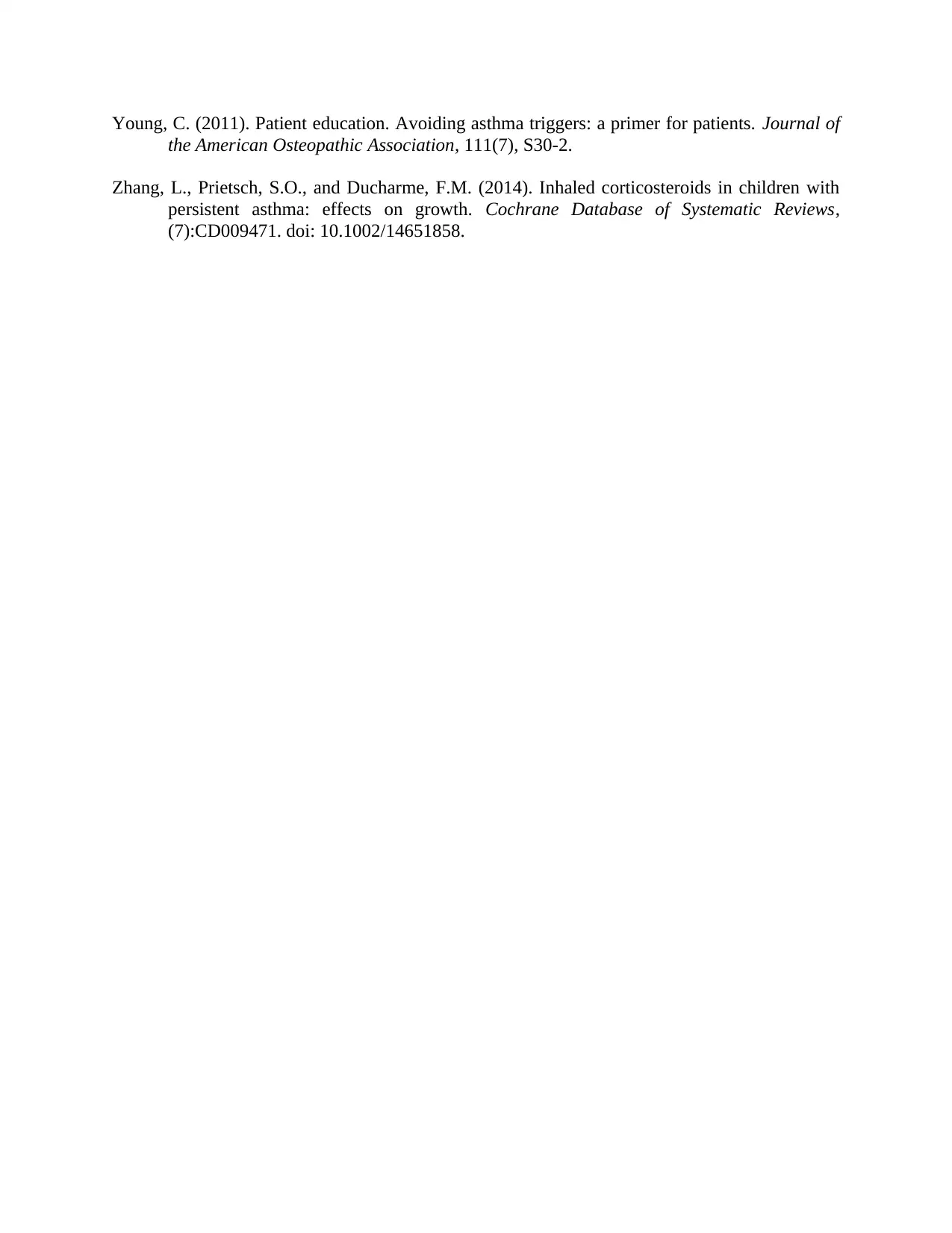
Young, C. (2011). Patient education. Avoiding asthma triggers: a primer for patients. Journal of
the American Osteopathic Association, 111(7), S30-2.
Zhang, L., Prietsch, S.O., and Ducharme, F.M. (2014). Inhaled corticosteroids in children with
persistent asthma: effects on growth. Cochrane Database of Systematic Reviews,
(7):CD009471. doi: 10.1002/14651858.
the American Osteopathic Association, 111(7), S30-2.
Zhang, L., Prietsch, S.O., and Ducharme, F.M. (2014). Inhaled corticosteroids in children with
persistent asthma: effects on growth. Cochrane Database of Systematic Reviews,
(7):CD009471. doi: 10.1002/14651858.
1 out of 7
Your All-in-One AI-Powered Toolkit for Academic Success.
+13062052269
info@desklib.com
Available 24*7 on WhatsApp / Email
![[object Object]](/_next/static/media/star-bottom.7253800d.svg)
Unlock your academic potential
Copyright © 2020–2025 A2Z Services. All Rights Reserved. Developed and managed by ZUCOL.
